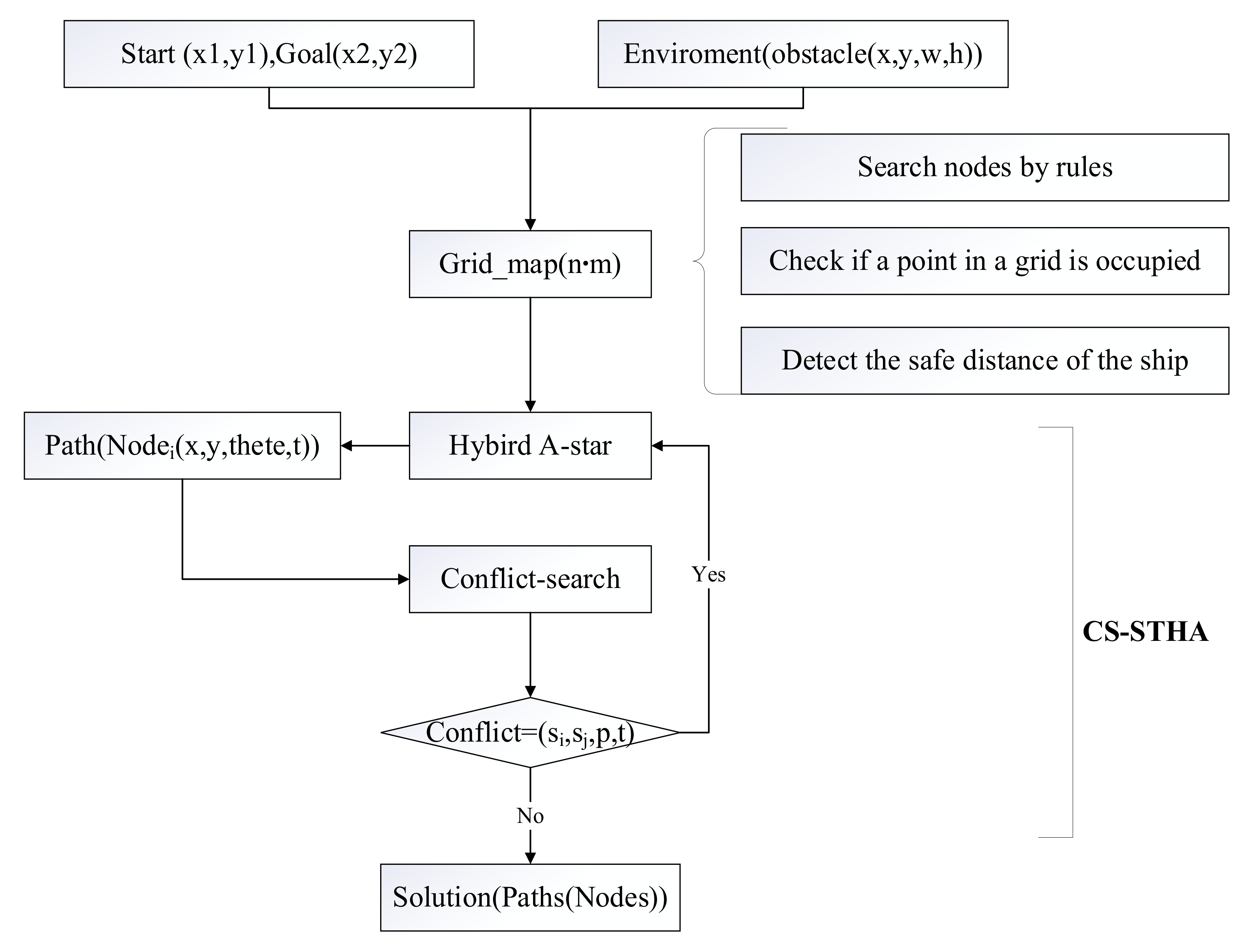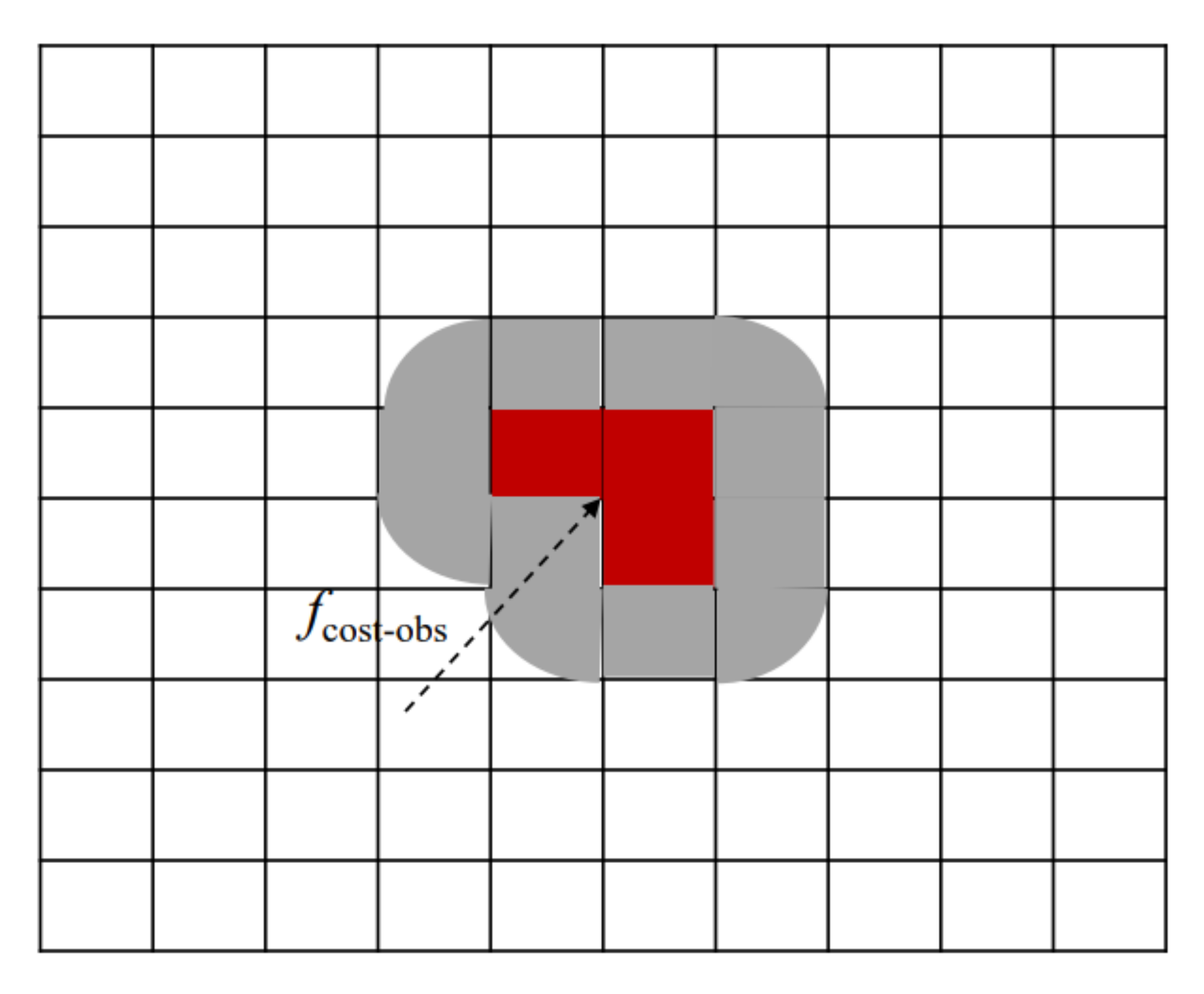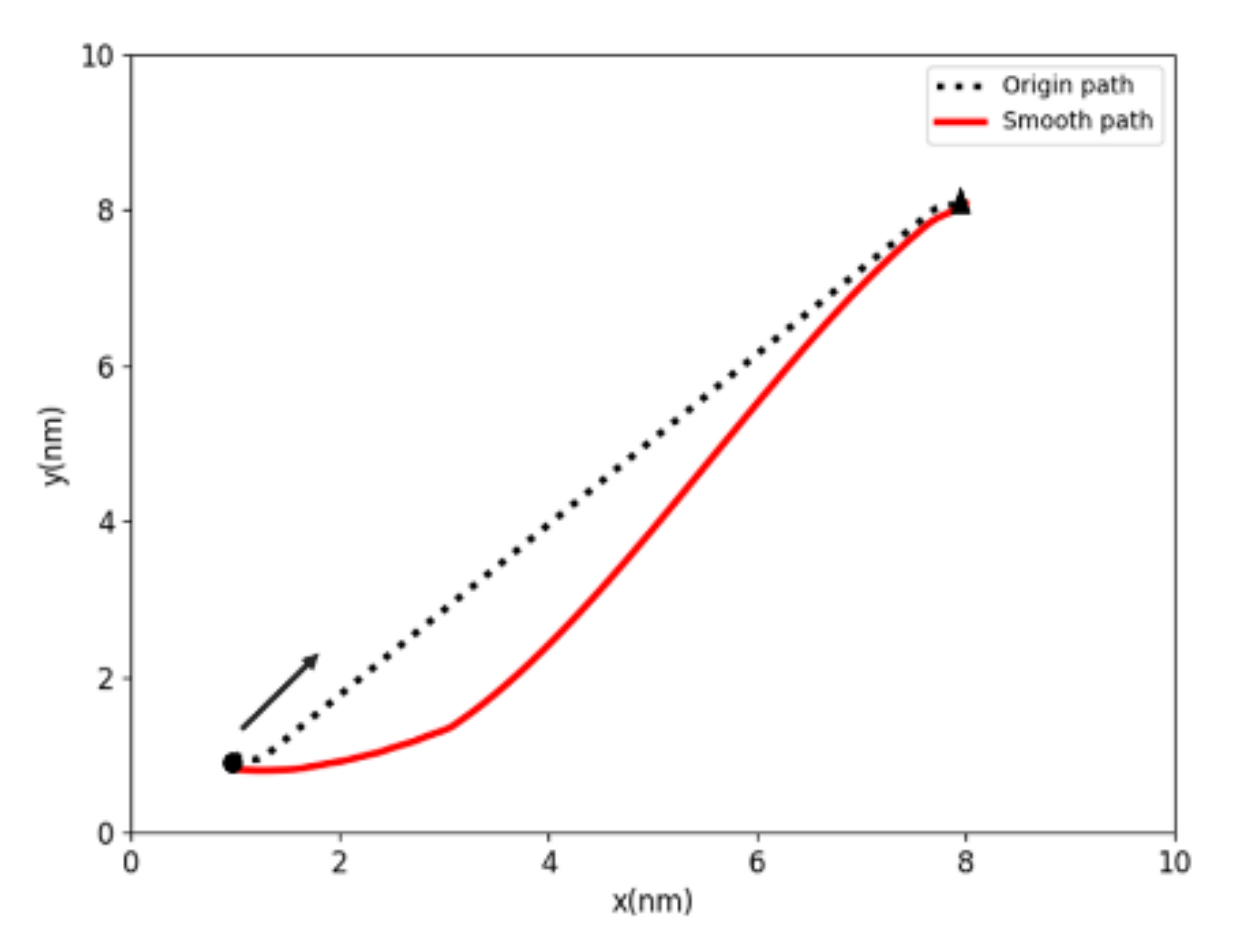Ship Collaborative Path Planning Method Based on CS-STHA
Abstract
:1. Introduction
1.1. Research Background
- (1)
- Accurate modeling of ship movement and surrounding dynamic environment;
- (2)
- Intelligent algorithms such as path planning algorithm, multi-objective optimization, artificial neural network and machine learning are combined.
- (3)
- Combine mathematical model with intelligent algorithm to build a hybrid intelligent system.
1.2. Literature Review
2. Model Based on the CS-STHA Method
2.1. Algorithm Principle
2.2. Ship Motion Model and Related Sonstraints
- (1)
- Ship motions model
- (2)
- Ship Maneuvering Constraints
- (3)
- The risk constraint function of ship safety distance and CRI
- (4)
- Ship Dubins Curve Trajectory Model
2.3. Environment Model
3. Path Planning Model Based on Conflict Search and STHA
3.1. Binary Tree Conflict Search Analysis
3.2. Space-Time Hybrid A-Star
3.3. Path Smoother
4. Simulation Analysis and Discussion
4.1. Two Ship Encounters
4.2. Muti-Ship Situation
4.3. Comparative Analysis of Real Ships
5. Conclusions
- (1)
- Add a time dimension to the Hybrid A-star algorithm and transform the time dimension into a path search scheme that conforms to the ship motion model and collision avoidance rules. The heuristic function considers the path distance cost, ship maneuvering constraints, and collision avoidance between ships.
- (2)
- Build a ship risk constraint based on the ship’s safety distance and fuzzy collision risk and assign the risk constraints through the binary tree to construct the space-time obstacle area.
- (3)
- Under the condition of global path planning, set a response mechanism. If other ships do not cooperate, the ship will be set as a dynamic obstacle, and the conflict search mechanism will be used to avoid collisions with multiple ships.
- (4)
- Use the cubic interpolation algorithm to make the shipping path more in line with the navigation control angle and navigation rules
- (5)
- Use two-ship and multi-ship encounter scenarios to verify the effectiveness of CS-STHA method in multi-ship collaborative collision avoidance, and then test the applicability and flexibility of the method in combination with actual simulation cases.
- (1)
- According to the three typical encounter situations established by COLREGs, the paths before and after collision avoidance are compared and analyzed based on the CS-STHA algorithm. Studies have shown that the CS-STHA algorithm maximizes the safety of the ship and adopts behaviors consistent with navigational maneuvers. Although part of the sailing distance will be lost to ensure the safety of the ship, the safety is greatly improved, and the distance cost is very small.
- (2)
- For the multi-ship encounter, the study designs three-ship, four-ship, and five-ship cases based on actual sailing cases, and analyzes the path cost and safety of the CS-STHA algorithm in the multi-ship encounter. Under the fuzzy ship collision risk calculation, the CS-STHA method can effectively ensure the safety of ships and make the minimum safety distance between ships within an acceptable safety range. At the same time, the multi-ship cooperative collision avoidance path scheme with the shortest total path distance is obtained.
- (3)
- To ensure the feasibility of ship simulation, this paper designs an actual ship encounter scheme based on the actual sailing case and compares the actual sailing and CS-STHA methods. The research shows that CS-STHA consumes less path cost, and the research in this paper is more in line with the actual navigation requirements.
- (4)
- The collision risk assessment in this paper adopts the ship domain model, and the distance between ships cannot be lower than the minimum safe distance between ships. Therefore, the optimal paths for all ships and other target ships are constrained by the ship’s safety distance.
- (5)
- The CS-STHA algorithm in this paper ensures the steering angle and turning radius constraints of the ship’s flexibility, improves the relative distance of the ship and the navigation safety of the ship, and reduces the risk of ship collision. Because the ship’s motion has the characteristics of large inertia, large time delay, nonlinear, and so on. Therefore, it is very necessary to consider the flexibility of the ship in the decision-making scheme of ship collision avoidance. CS-STHA uses the Hybrid A* algorithm to increase the search range of navigation points and uses the Dobbins curve model and ship motion model to derive the turning radius and navigation angle, narrowing the gap between collision avoidance algorithms or decision-making systems and practical applications, taking into account the flexibility of the ship. The effectiveness of the method is verified by the calculation of actual navigation cases.
Author Contributions
Funding
Institutional Review Board Statement
Informed Consent Statement
Acknowledgments
Conflicts of Interest
References
- Tam, C.; Bucknall, R.; Greig, A. Review of Collision Avoidance and Path Planning Methods for Ships in Close Range Encounters. J. Navig. 2009, 62, 455–476. [Google Scholar] [CrossRef]
- Lazarowska, A.; Żak, A. A Concept of Autonomous Multi-Agent Navigation System for Unmanned Surface Vessels. Electronics 2022, 11, 2853. [Google Scholar] [CrossRef]
- Zhang, K.; Huang, L.; Liu, X.; Chen, J.; Zhao, X.; Huang, W.; He, Y. A Novel Decision Support Methodology for Autonomous Collision Avoidance Based on Deduction of Manoeuvring Process. J. Mar. Sci. Eng. 2022, 10, 765. [Google Scholar] [CrossRef]
- Lee, H.; Motes, J.; Morales, M.; Amato, N. Parallel Hierarchical Composition Conflict-Based Search for Optimal Multi-Agent Pathfinding. IEEE Robot. Autom. Lett. 2021, 6, 7001–7008. [Google Scholar] [CrossRef]
- Krishnamurthy, P.; Khorrami, F.; Ng, T.L. Obstacle Avoidance for Unmanned Sea Surface Vehicles: A Hierarchical Approach. IFAC Proc. Vol. 2008, 41, 6798–6803. [Google Scholar] [CrossRef] [Green Version]
- Wang, X.; Yao, X.; Zhang, L. Path Planning under Constraints and Path Following Control of Autonomous Underwater Vehicle with Dynamical Uncertainties and Wave Disturbances. J. Intell. Robot. Syst. 2020, 99, 891–908. [Google Scholar] [CrossRef]
- Tian, Y.; Huang, L.; Xiong, Y.; Li, S. On the velocity obstacle based automatic collision avoidance with multiple target ships at sea. In Proceedings of the 2015 International Conference on Transportation Information and Safety (ICTIS), Wuhan, China, 25–28 June 2015; pp. 468–472. [Google Scholar]
- Benjamin, M.R.; Curcio, J.A. COLREGS-based navigation of autonomous marine vehicles. In Proceedings of the IEEE/OES Autonomous Underwater Vehicles (IEEE Cat. No. 04CH37578), Sebasco, ME, USA, 17–18 June 2004; pp. 32–39. [Google Scholar]
- Naeem, W.; Irwin, G.W. An Automatic Collision Avoidance Strategy for Unmanned Surface Vehicles; Springer: Berlin/Heidelberg, Germany, 2010; pp. 184–191. ISBN 1865-0929. [Google Scholar]
- Yao, X.; Wang, X.; Wang, F.; Zhang, L. Path Following Based on Waypoints and Real-Time Obstacle Avoidance Control of an Autonomous Underwater Vehicle. Sensors 2020, 20, 795. [Google Scholar] [CrossRef] [PubMed] [Green Version]
- Zhai, P.; Zhang, Y.; Shaobo, W. Intelligent Ship Collision Avoidance Algorithm Based on DDQN with Prioritized Experience Replay under COLREGs. J. Mar. Sci. Eng. 2022, 10, 585. [Google Scholar] [CrossRef]
- Pietrzykowski, Z.; Wołejsza, P.; Nozdrzykowski, Ł.; Borkowski, P.; Banaś, P.; Magaj, J.; Chomski, J.; Mąka, M.; Mielniczuk, S.; Pańka, A.; et al. The autonomous navigation system of a sea-going vessel. Ocean Eng. 2022, 261, 112104. [Google Scholar] [CrossRef]
- Lazarowska, A. Method of considering the dynamics of a ship in the process of determining a safe trajectory using an algorithm based on Ant Colony Optimization. In Proceedings of the 2016 21st International Conference on Methods and Models in Automation and Robotics (MMAR), Miedzyzdroje, Poland, 29 August–1 September 2016; pp. 625–629. [Google Scholar] [CrossRef]
- Lisowski, J. Synthesis of a Path-Planning Algorithm for Autonomous Robots Moving in a Game Environment during Collision Avoidance. Electronics 2021, 10, 675. [Google Scholar] [CrossRef]
- Wang, H.; Fu, Z.; Zhou, J.; Fu, M.; Ruan, L. Cooperative collision avoidance for unmanned surface vehicles based on improved genetic algorithm. Ocean Eng. 2021, 222, 108612. [Google Scholar] [CrossRef]
- Liu, F. Research on Ship Path Planning Method Based on Deep Reinforcement Learning. Ph.D. Thesis, Wuhan University of Technology China, Wuhan, China, 2020. [Google Scholar]
- Chen, C.; Ma, F.; Xu, X.; Chen, Y.; Wang, J. A Novel Ship Collision Avoidance Awareness Approach for Cooperating Ships Using Multi-Agent Deep Reinforcement Learning. J. Mar. Sci. Eng. 2021, 9, 1056. [Google Scholar] [CrossRef]
- Ahmed, Y.A.; Hannan, M.A.; Oraby, M.Y.; Maimun, A. COLREGs Compliant Fuzzy-Based Collision Avoidance System for Multiple Ship Encounters. J. Mar. Sci. Eng. 2021, 9, 790. [Google Scholar] [CrossRef]
- Aguiar, A.P.; Hespanha, J.P. Trajectory-Tracking and Path-Following of Underactuated Autonomous Vehicles with Parametric Modeling Uncertainty. IEEE Trans. Autom. Control 2007, 8, 1362–1379. [Google Scholar] [CrossRef] [Green Version]
- Kang, Y.; Chen, W.; Zhu, D.; Wang, J. Collision avoidance path planning in multi-ship encounter situations. J. Mar. Sci. Tech.—Jpn. 2021, 26, 1026–1037. [Google Scholar] [CrossRef]
- Song, R.; Liu, Y.; Bucknall, R. Smoothed A algorithm for practical unmanned surface vehicle path planning. Appl. Ocean Res. 2019, 83, 9–20. [Google Scholar] [CrossRef]
- Miao, T.; Amam, E.E.; Slaets, P.; Pissoort, D. An improved real-time collision-avoidance algorithm based on Hybrid A* in a multi-object-encountering scenario for autonomous surface vessels. Ocean Eng. 2022, 255, 111406. [Google Scholar] [CrossRef]
- Li, J.; Felner, A.; Boyarski, E.; Ma, H.; Koenig, S. Improved Heuristics for Multi-Agent Path Finding with Conflict-Based Search. In Proceedings of the Twenty-Eighth International Joint Conference on Artificial Intelligence (IJCAI-19), Macao, China, 10–16 August 2019. [Google Scholar]
- Codesseira, V.C.; Tannuri, E.A. Path Following Control for Autonomous Ship using Model Predictive Control. IFAC-PapersOnLine 2021, 54, 57–62. [Google Scholar] [CrossRef]
- Quy, N.M.; Bazuga, K.; Gucma, L.; Vrijling, J.K.; van Gelder, P.H.A.J. Towards generalized ship’s manoeuvre models based on real time simulation results in port approach areas. Ocean Eng. 2020, 209, 107476. [Google Scholar] [CrossRef]
- Qiu, Z.; Lan, P. A Synthetic Decision System for Ship Collision Avoidance. Navig. China 1992, 2, 48–56. [Google Scholar] [CrossRef]
- Abebe, M.; Noh, Y.; Seo, C.; Kim, D.; Lee, I. Developing a Ship Collision Risk Index estimation model based on Dempster-Shafer theory. Appl. Ocean Res. 2021, 113, 102735. [Google Scholar] [CrossRef]
- Xu, W.; Hu, J.Q.; Yin, J.C.; Li, K. Composite evaluation of ship collision risk index based on fuzzy theory. Ship Sci. Technol.—China 2018, 40, 52–56. [Google Scholar] [CrossRef]
- Wang, X. Motion Control and Path Planning Research for Underactuated Autonomous Underwater Vehicle. Ph.D. Thesis, Harbin Engineering University, Harbin, China, 2020. [Google Scholar]
- Gao, Q.; Song, L.; Yao, J. RANS Prediction of Wave-Induced Ship Motions, and Steady Wave Forces and Moments in Regular Waves. J. Mar. Sci. Eng. 2021, 9, 1459. [Google Scholar] [CrossRef]
- Borkowski, P. Numerical Modeling of Wave Disturbances in the Process of Ship Movement Control. Algorithms 2018, 11, 130. [Google Scholar] [CrossRef] [Green Version]
- Liu, J.; Zhao, B.; Li, L. Collision Avoidance for Underactuated Ocean-Going Vessels Considering COLREGs Constraints. IEEE Access 2021, 9, 145943–145954. [Google Scholar] [CrossRef]




















| Case | Ship List | Start-Position | Course (°) | Goal-Position |
|---|---|---|---|---|
| overtaking | OS | (25.81938672190124, −80.15101723193693) | 90 | (25.85212101688134, −80.0051096817491) |
| TS | (25.85212101688134, −80.0051096817491) | 270 | (25.85212101688134, −80.0051096817491) | |
| Crossing | OS | (25.901449816529674, −80.15100458314197) | 45 | (25.78648996276379, −80.02342829513535) |
| TS | (25.786561484048686, −80.15102227956486) | 315 | (25.901378126712103, −80.0232867241675) | |
| Head-on | OS | (25.797386913628763, −80.1207598367107) | 90 | (25.901358781858733, −80.00504133260878) |
| TS | (25.80953821635524, −80.1446378084954) | 75 | (25.848339881095615, −79.99964375266372) |
| Case | Ship List | Start-Position | Course (°) | Goal-Position |
|---|---|---|---|---|
| Three-ship | Ship1 | (25.81938672190124, −80.15101723193693) | 90 | (25.85212101688134, −80.0051096817491) |
| Ship2 | (25.884946193546583, −80.00506413096967) | 270 | (25.802974102975046, −80.15101975659907) | |
| Ship3 | (25.78648996276379, −80.02342829513535) | 315 | (25.901449816529674, −80.15100458314197) | |
| Four-ship | Ship1 | (25.802974102975046, −80.15101975659907) | 45 | (25.901378126712103, −80.0232867241675) |
| Ship2 | (25.78656006497455, −80.14190841956533) | 60 | (25.917807796255882, −80.04151437734187) | |
| Ship3 | (25.81108954597314, −80.00516653418576) | 300 | (25.901448394111643, −80.14188187493257) | |
| Ship4 | (25.78648996276379, −80.02342829513535) | 0 | (25.917787033376307, −80.01961685956509) | |
| Five-ship | Ship1 | (25.786561484048686, −80.15102227956486) | 45 | (25.901378126712103, −80.0232867241675) |
| Ship2 | (25.80296923107549, −80.12732044132656) | 60 | (25.906346289032157, −80.07801912836804) | |
| Ship3 | (25.868624078324324, −80.1473615773753) | 180 | (25.85212101688134, −80.0051096817491) | |
| Ship4 | (25.885028097190915, −80.11452135171605) | 160 | (25.866892346387452, −80.00508919147534) | |
| Ship5 | (25.917822594366235, −80.0597623142908) | 180 | (25.794725282277557, −80.0562303404331) |
| Case | Ship List | Start-Position | Course (°) | Goal-Position |
|---|---|---|---|---|
| Real | Ship1 | (25.802970696052224, −80.13278951389665) | 90 | (25.901395195706737, −80.04153212134828) |
| Ship2 | (25.88996098328195, −80.15100635653317) | 90 | (25.880011895778633, −79.99594992040794) | |
| Ship3 | (25.860418269215984, −80.1510109128528) | 45 | (25.868533605220787, −80.00508691401308) |
Publisher’s Note: MDPI stays neutral with regard to jurisdictional claims in published maps and institutional affiliations. |
© 2022 by the authors. Licensee MDPI, Basel, Switzerland. This article is an open access article distributed under the terms and conditions of the Creative Commons Attribution (CC BY) license (https://creativecommons.org/licenses/by/4.0/).
Share and Cite
Yao, J.; Gang, L. Ship Collaborative Path Planning Method Based on CS-STHA. J. Mar. Sci. Eng. 2022, 10, 1504. https://doi.org/10.3390/jmse10101504
Yao J, Gang L. Ship Collaborative Path Planning Method Based on CS-STHA. Journal of Marine Science and Engineering. 2022; 10(10):1504. https://doi.org/10.3390/jmse10101504
Chicago/Turabian StyleYao, Jiyu, and Longhui Gang. 2022. "Ship Collaborative Path Planning Method Based on CS-STHA" Journal of Marine Science and Engineering 10, no. 10: 1504. https://doi.org/10.3390/jmse10101504
APA StyleYao, J., & Gang, L. (2022). Ship Collaborative Path Planning Method Based on CS-STHA. Journal of Marine Science and Engineering, 10(10), 1504. https://doi.org/10.3390/jmse10101504






